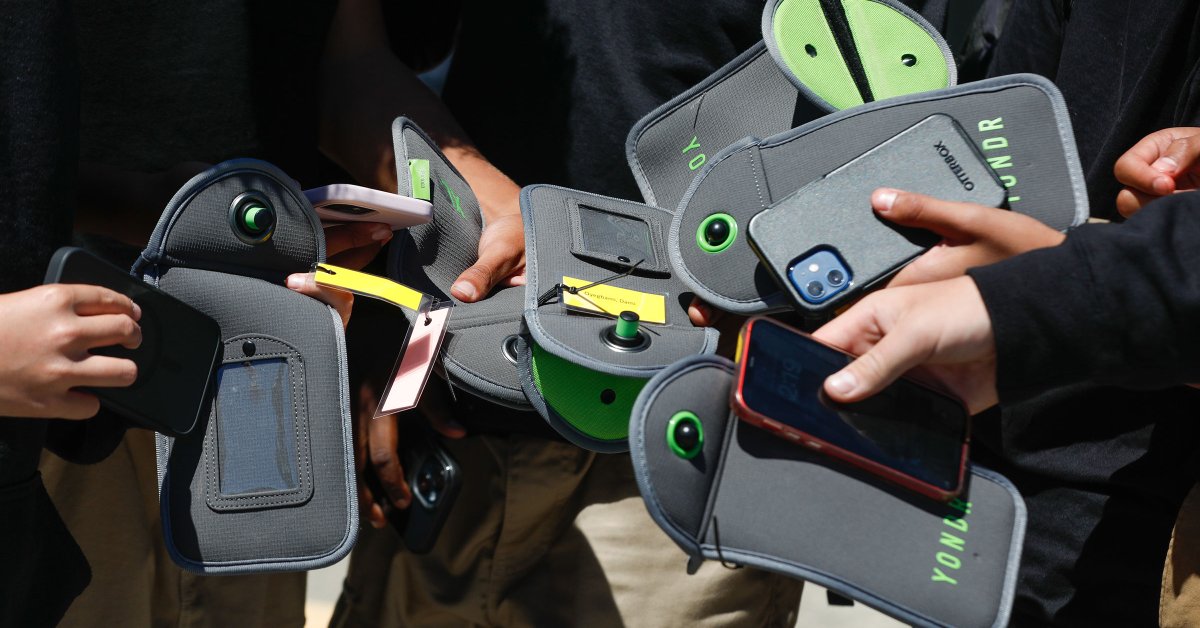Before she had four kids and moved to rural Vermont, Laura Derrendinger was a public-health nurse for Doctors Without Borders. She spent eight years in places like Kosovo, Sudan, and the Congo-Uganda border, treating children with preventable illnesses like cholera, malaria, and measles. She learned the best way to stop disease is before it begins, with “upstream” interventions to remove the pathogen from the environment.
These days, nearly two decades after her last field assignment, Derrendinger is taking on a new pathogen that she thinks affects nearly every child in America. “In malaria, the mosquito is the vector of disease,” she says. “Here, the phone is the vector that’s carrying the disease of toxic online content.”
Derrendinger is just one dedicated organizer in a growing constellation of parent-led groups working to break Big Tech’s grip on children. She helps lead the Distraction Free Schools Policy Project, she’s on the leadership council of Smartphone Free Childhood US, and she’s a member of the Screen Time Action Network, ScreenStrong, Mothers Against Media Addiction, Tech Safe Learning Coalition, and the Vermont Coalition for Phone and Social Media Free Schools—all interconnected organizations with overlapping membership and converging goals. Much of their advocacy is focused on pushing for the simplest way to address social-media addiction in kids: making American schools into phone-free environments.
Two years ago, banning phones in schools seemed almost unthinkable. Now, thanks in part to parents’ organizing efforts, support for phone-free schools is rising quickly levels in a country that can’t seem to agree on much else. A Pew Research Center study in July found that 74% of U.S. adults now support preventing middle schoolers and high schoolers from using their phones during class, up from 68% last year, while 44% support banning phones for the entire school day, up from 36%. Roughly two-thirds of Americans think phone-free schools would improve students’ social skills, grades, and behavior in class.
Read More: She Says Social Media Algorithms Led to An Eating Disorder. Now She’s Suing.
State lawmakers from both parties are listening. As of this summer, 37 states have banned cell phones and other internet-connected devices during class. About half of those states and D.C. are phone-free from “bell-to-bell,” which keeps kids from accessing their phones during lunch and between classes. Republican states like Alabama, Arkansas, Nebraska, and Oklahoma have passed bell-to-bell laws, while deep-blue New York just became the largest state to go phone-free for the entire school day starting this fall.
“To be frank, I thought we’d be socializing the idea of phone-free schools with state legislators this year,” says Josh Golin, executive director of Fairplay, one of the central organizations in the network of parents, educators, and advocates working to combat social-media addiction in kids. “The fact that so many of these bills have already passed is a testament to how quickly this movement is coming together and to how angry parents are.”
The rapid momentum reflects a growing understanding that phones and social media can present serious harms to kids’ mental health and social development. So while some 14-year-olds get a phone for their birthday, Derrendinger got her son something she thought was much less dangerous: a chainsaw.
Parents have long sensed that smartphones were transforming childhood. But it’s only recently that they’ve finally had the language to describe what’s happening. Last year, Jonathan Haidt’s The Anxious Generation was published to broad acclaim. The book, which argues that smartphones and social media have transformed a “play-based childhood” into what Haidt calls a “phone-based childhood,” has spent 70 weeks on the New York Times bestseller list, and spawned a grassroots movement and public-awareness campaign advocating for less screen time and more real-world independence for kids. Advocates who had been pushing to reduce screen time suddenly found themselves flooded with new volunteers. “The momentum came from his book,” says Kim Whitman, who co-leads Smartphone Free Childhood US. “But it’s a lot of us moms out there doing the actual work. We’re the boots on the ground, pushing it forward.”
In the year since The Anxious Generation was published, parents formed a loose coalition of advocacy groups focused on pushing school administrators, superintendents, and state legislatures to make schools phone-free. Many of these groups are connected through Fairplay, an advocacy organization that was founded 20 years ago as the Campaign for a Commercial Free Childhood. In 2017, Fairplay launched the Screen Time Action Network, which became an incubator for the movement to get phones out of schools.
At first, many dismissed worries about screen time as a vaguely crunchy domestic concern, like “gentle parenting” or the push for organic foods. That changed in 2020. Parents stuck at home with their kids during the COVID-19 pandemic saw their children’s phone addiction firsthand. New research linked social media to a worsening mental-health crisis among kids and teenagers. After the movie The Social Dilemma was released in 2020, parents who had lost children to that mental health crisis began to find each other. Fairplay saw an influx of these so-called “survivor parents,” who had lost children to harms encountered on social media. With Fairplay’s help, those parents formed a group called Parents for Safe Online Spaces.
“The Anxious Generation has turbocharged everything, but a lot of these pieces were coming together before that,” says Golin of Fairplay. For years, parents faced a choice between exposing their kids to unknown dangers on social-media platforms or fighting a constant battle that would leave their kids isolated and miserable. ”There’s now community in resisting the phone-based childhood.”
Derrendinger, Whitman, and their fellow advocate Deb Schmill first met through Fairplay’s Screen Time Action Network. Every Wednesday at noon for the past six months, they lead a Zoom forum for parent-advocates from around the country, called Distraction Free Schools Policy Project. The group includes parents from 30 states, strategizing about everything from how to draft a bill to how to build relationships with state legislators to how to create local pressure to pass phone-free legislation in their states. The advocates all agree that “bell-to-bell” policies, rather than ones that allow students to use phones between class, are the best way to reduce distractions and break social media addictions.
The call begins with some quick housekeeping from Derrendinger, but the Zoom quickly fills with eager conversation. Some parents had questions: “When they do bell-to-bell, what’s the rule for teachers?” asked one mom from Pennsylvania. Others had complaints about how the rules have been poorly enforced: “They’re still allowing phones in backpacks,” said a mom in New York, lamenting that her school district’s policy “basically has no teeth to it.” Another from Illinois reluctantly reported that her state’s phone-free legislation had passed the Senate but stalled in the House. “While you’re figuring out what the solution should look like, kids out there are struggling,” she said. “Parents are struggling. Schools are struggling.”
At the end of the call, Schmill announced the next steps. “The goal for next year is to find champions in the states that did not pass bell-to-bell. And that’s best done in the summer,” she explained. Derrendinger chimed in. “Summertime is the best time to build these allies,” she said. “See if you can have coffee and connect in a human way with some of these legislators.”
After the meeting ends, Derrendinger sends a follow-up email to the group. It includes a call to action reminding members to speak to their local school board or state board of education. “We will get this fixed,” Derrendinger writes in the email. “Remember, we move fast and fix things!”
For some of the moms dedicating themselves to changing the way kids interact with technology, the issue is deeply personal. Deb Schmill’s daughter, Becca, died in 2020 after taking drugs that were laced with fentanyl. She was 18. Deb Schmill believes social media led to Becca’s overdose, fueling a series of traumatic events that dramatically shaped her adolescence.
When Becca was 15, according to her mother, she was drugged and raped by a boy she and her friends had met on a group chat. In the months that followed, Deb Schmill says, Becca was the victim of revenge porn circulated around her high school via social media. “These two traumas within a couple months of each other sent her spiraling,” Schmill says, causing Becca to develop addiction issues.
In 2020, Deb and Becca temporarily relocated to Maine to get away from Becca’s drug dealer. “With her phone, she could just track down a drug dealer with social media and pick something up,” Schmill recalls. “It was laced with fentanyl. And we lost her.”
Over the years since, Schmill has struggled to make sense of the cascading tragedies that led to her daughter’s death. In each trauma, she concluded, technology was partly to blame. Group chats made it easy for teens to connect with strangers, like the boy from another town who allegedly raped her. Without social media, “there wouldn’t be a place for revenge porn where people can post the most humiliating moments of your life online,” Schmill says. And when these traumas became too much for Becca, her mother says, her phone also gave her “easy access to drugs.”
Schmill runs the Becca Schmill Foundation, but is also an active member of many other groups. She is among the “survivor parents” lobbying Congress to pass the Kids Online Safety Act, which would create a “duty of care” making social-media companies legally required to prevent and mitigate harms on their platforms. The bill, known as KOSA, passed the Senate overwhelmingly last year before stalling in the House. (It was re-introduced in May.) “A lot of these organizations are working on different pieces of the puzzle,” Schmill says. “Because no one solution is going to fix this.”
One day in the spring of 2023, Derrendinger invited Vermont state senator Terry Williams to her home before breakfast. They sat on her porch on a frigid morning, before Derrendinger’s four kids woke up. Derrendinger blasted Williams, a Republican, with a “firehose” of data about the dangers of screens for kids. A few months later, Williams was invited back; this time Derrendinger had also invited three other moms. As they drank lemonade and the children played in the yard, Derrendinger laid out their request for Williams. The parents had drafted a bill to make Vermont schools phone and social-media free. It was a bell-to-bell phone ban that also included other devices like smartwatches, and it forbade schools from communicating with students via social media. All Williams had to do was introduce it.
Williams was skeptical at first. “Everybody was against it,” he says. Many parents wanted their kids to have phones at school so they could be reached if necessary. Teachers didn’t want to have to enforce a state law. Still, Derrendinger’s data on the subject was persuasive. She kept calling Williams about it. He agreed to co-sponsor the bill that Derrendinger and her group had drafted.
“I said, ‘Don’t get your hopes up,’” Williams recalls. He would introduce it, he told the parents, but once it went into the relevant legislative committee, “You’re pretty much on your own.’”
That was fine with Derrendinger’s group. They had an army of advocates at the ready. The original bill failed in 2024, but the group revived it in 2025 with the help of Rep. Angela Arsenault, a Democrat who co-sponsored the new bill in Vermont’s House of Representatives. Rep. Arsenault says the grassroots momentum from parent advocates was what got the bill over the finish line during a busy legislative season. “I am certain that that bill moved this year because of the parent-led movement,” she says. Williams says the public support was so overwhelming that his office got more than 1,500 emails urging him to support the bill, even though he was already a co-sponsor. “It was the local groups,” he says. “They were relentless.”
In June, Vermont passed two of the strictest laws in the nation regulating children’s access to technology. The first, Vermont’s Age Appropriate Design Code, establishes a “duty of care” for social-media companies to design their products with kids’ safety in mind, bans design features like endless scrolling and targeted advertising, and requires platforms to verify ages of minors and give them the highest privacy settings by default—essentially the statewide version of KOSA. The second, a statewide “bell-to-bell” phone and device ban in K-12 schools, makes all Vermont schools phone-free throughout the entire school day. It also made Vermont the first state to prohibit schools (or sports teams or student councils) from using social media to communicate with students.
While some educators resisted, others were thrilled. Blake Fabrikant has seen the benefits of phone-free schools as the dean of students at The Sharon Academy, a small independent high school in Sharon, Vt. Starting in 2015, Fabrikant began to notice a change in the school’s social dynamics. “When students had free time, they were going on their phones instead of integrating with each other and building social skills,” he says. Attention spans decreased. Students made fewer friends. The culture of the school started to atrophy.
Fabrikant had been pushing to go phone-free for years, but he finally got the school to implement a bell-to-bell phone ban in the summer of 2024. It was “a tremendous success,” he says. Grades are up, according to Fabrikant, and students are paying more attention in class without the temptation to check Instagram. “Two years ago you’d walk through the hallways and kids would just be glued to their phones,” he says. Now, “they’re going outside and playing volleyball together. A student brings a boombox to school and they all dance together.” The benefits to students’ academic and social advancement, Fabrikant says, have been “exponential.”
For these parents and advocates, phone-free schools are just the beginning. The broad consensus that phones are harming children has opened up a whole new range of possibilities. “We’ve moved from arguing about whether there was a problem,” says Fairplay’s Josh Golin, “to arguing about what the solutions are.”








